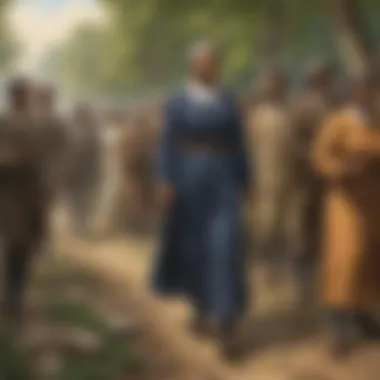The Life and Legacy of Harriet Tubman: A Historical Overview


Intro
The journey of Harriet Tubman is not merely a tale confined to the pages of history books; it breathes life into the very essence of American courage and resilience. Born into the dark shadow of slavery, Tubman's existence was marked by hardship, but her spirit remained unbroken. This article highlights the significant events surrounding her birth and death, and it unpacks her relentless struggle for freedom.
Understanding her legacy is key in today’s world, where themes of justice and equality still resonate deeply. Tubman's life serves as a reminder that determination can challenge societal norms, paving the way for change.
As we delve into her early life, we find that many factors molded her worldview—her experiences, the influence of her community, and the unyielding desire for freedom. We later explore her death, reflecting on how she continues to inspire countless individuals, and how her contributions have left an indelible mark on history.
With this foundation, we step into the remarkable chapters of Harriet Tubman's life—the moments that forged her unbreakable spirit.
Early Life: Origins and Upbringing
Understanding Harriet Tubman's early life is crucial to grasping the motivations and experiences that shaped her into one of the most formidable figures in American history. Her origins played a significant role in forming her indomitable spirit and fierce determination. Tubman's journey began in a world constricted by the chains of slavery, and this environment influenced not just her actions but also the broader movement for liberation.
Birthplace and Date
Born in the early 1820s, Harriet Tubman entered this world in a small farmhouse on the Edward Brodess plantation, situated in Dorchester County, Maryland. The exact date of her birth remains ambiguous, but it is estimated to be between 1820 and 1825. This region was a microcosm of the harsh realities of slavery, where human lives were reduced to property, and families were frequently torn apart by the whims of their owners.
This birthplace was not just a geographical location but a battleground of sorts, where the struggle for freedom began in earnest. In the heart of Maryland, Tubman faced severe restrictions right from her earliest days. Growing up surrounded by the entrenched norms of slavery, she witnessed the cruelty that governed the lives of her family and the enslaved individuals around her.
Family Background
Harriet's family lineage was intertwined with the very fabric of slavery itself. Her parents, Harriet Green and Benjamin Ross, were both enslaved Africans. Benjamin had the privilege of being allowed to be with his family, yet this situation was tenuous at best. The instability of their existence invoked a sense of urgency in Tubman, who later recounted the fears and struggles of her youth. Having experienced the constant threat of sale and separation firsthand, she developed a profound understanding of the injustices that needed addressing.
Through her family, Harriet learned about resilience; her mother, a skilled cook, fought fiercely to keep her children close, while her father’s quiet strength instilled values of determination and hope. These familial bonds would become pivotal in developing her resolve to fight for both her freedom and that of others.
Childhood Experiences
From an early age, Tubman’s childhood was marked by difficulties and challenges. She experienced harsh treatment, lack of freedom, and the expectation that she would perform backbreaking labor. As a child, Tubman faced a traumatic head injury from a heavy object that struck her — a brutal reminder of the dangers and adversities surrounding her. This incident resulted in lifelong health problems, but it also seemed to imbue her with a deeper understanding of pain, both physical and emotional.
Despite these challenges, Tubman found solace in her dreams of freedom. Her early experiences, whether helping her family in the fields or listening to stories of escape from those who had managed to flee, shaped her understanding of liberation. She experienced the pains of separation when family members were sold off and knew, from a young age, what a heavy price freedom could demand.
Ultimately, Harriet Tubman's early life laid the groundwork for her later actions. Her birthplace, family background, and childhood experiences instilled in her an unquenchable thirst for freedom, not just for herself but for every enslaved person in America.
"Every great dream begins with a dreamer. Always remember, you have within you the strength, the patience, and the passion to reach for the stars to change the world."
This quote resonates deeply with her journey, reminding us of her relentless pursuit of liberation and justice.
Historical Context of Her Birth
Understanding the historical context of Harriet Tubman's birth is crucial for grasping the complexities of her life and legacy. Her experiences were shaped not only by her personal circumstances but also by the broader societal structures of her time. The backdrop of slavery in America in the early nineteenth century created a harsh reality for countless African Americans, turning their lives into a constant fight for freedom. It is within this framework that Tubman's resilience and extraordinary efforts can truly be appreciated, adding layers of meaning to her eventual impact on history and social justice.


Slavery in Early Nineteenth Century America
In the early 1800s, the institution of slavery was deeply entrenched in the United States, particularly in southern states. The economy was largely built around agricultural labor, and enslaved people were considered property rather than human beings. An estimated two million enslaved individuals existed at the start of the nineteenth century, living under inhumane conditions. They faced brutal treatment, forced labor, and systematic dehumanization, which made the quest for freedom perilous and fraught with danger.
Slavery was not only a physical bondage but also a psychological one; it stripped individuals of their identities and stripped them of their rights. Families were often torn apart, with loved ones sold to different slave owners, creating a sense of hopelessness. For Tubman, born around 1822, this was more than a historical point; it was her lived reality. Such conditions motivated many to seek freedom, setting the stage for what would become Tubman's lifelong mission.
Impact of the Abolitionist Movement
The abolitionist movement was gaining momentum in the early nineteenth century, providing a glimmer of hope for those yearning for emancipation. It brought together a diverse coalition of individuals, including free African Americans, white sympathizers, and those driven by moral or religious convictions. Prominent figures like William Lloyd Garrison and Frederick Douglass began to challenge the status quo, advocating for the end of slavery and encouraging collective action.
The movement was marked by passionate speeches, publications, and grassroots organizing. Abolitionists held rallies, published newspapers, and wrote pamphlets to raise awareness about the plight of enslaved people. This period also saw the establishment of safe havens for runaway slaves, with the Underground Railroad serving as a primary escape route.
Journey to Freedom
The journey to freedom is a cornerstone of Harriet Tubman's story, embodying her relentless quest for liberty amid the shackles of slavery. This section stands crucial because it sheds light on her transformation from a slave to a key figure in the abolitionist movement. Understanding this journey provides a framework for grasping not just Tubman’s individual struggle but also the broader fight for freedom by countless individuals during that period.
Escape from Slavery
The escape from slavery is often romanticized in popular culture, but for Tubman, it was a matter of life and death. In September 1849, after learning that she and her brothers were to be sold, Tubman made the bold decision to flee from the Thompson family's plantation in Maryland. With her own dreams of freedom weighing heavily on her mind and a simmering determination to forge a life away from the torment of slavery, she set out on a journey fraught with danger.
Traveling by night and using the stars as her guide, Tubman evoked the utmost resourcefulness. She navigated through woods and fields, often hiding in the densest parts of nature to evade the watchful eyes of slave catchers. Each step was a calculated risk; one wrong move could lead her back to captivity.
Moreover, it’s worth highlighting how Harriet Tubman was not just running away—she was also actively challenging the institution that sought to bind her. Her escape showcased the immense courage she possessed and set the stage for her future as a conductor on the Underground Railroad. Tubman once said, "I should fight for my liberty so long as there is breath in me," leaving no doubt about her unwavering resolve.
Role as a Conductor on the Underground Railroad
After gaining her own freedom, Tubman took on the monumental task of guiding others to safety via the Underground Railroad. This network of secret routes and safe houses was established by abolitionists, aimed at assisting escaped slaves. Tubman's role evolved from a fugitive to a conductor—someone who led others on their own journeys to freedom. Just like a guiding star, she marked paths toward liberation.
From 1850 to 1860, Tubman made an astonishing 13 missions back to the South. Using her extensive knowledge of the land, she helped around 70 enslaved people escape. Every journey bore the weight of anxiety; the threat of capture loomed large. Yet, Tubman's unyielding faith and tactical prowess minimized risks.
Unsurprisingly, these missions were more than just logistical escapades. They were steeped in the idea of community and mutual support. Each person she led was not merely a face but a life that mattered. Tubman often remarked, "Every great dream begins with a dreamer." Her conviction transformed dreams into reality, giving her passengers hope and courage to face unknown futures.
Remember: The role that Tubman played in the Underground Railroad was not just about physical escape—it was about crafting a legacy of freedom, bravery, and collective struggle that continues to echo through generations.
"It is not the person who has been living as a slave that is lost. It is the one who is free but afraid to make the leap that remains a captive." - Harriet Tubman
In summary, the importance of the 'Journey to Freedom' illuminates not just Tubman's life but the unyielding spirit of those who dared to dream of a better existence. Her experiences showcase the intersection of personal struggle and collective action in the fight against the oppression of slavery.
Significant Contributions
Harriet Tubman’s impact on American history resonates far beyond her time. Her significant contributions to the abolitionist movement and her pivotal role during the Civil War not only underscore her as a formidable leader but also render her a symbol of courage, determination, and resilience. By examining these contributions, one can appreciate the breadth of her influence on society, culture, and the ongoing fight for justice and equality.


Abolitionist Activities
In the 19th century, the fight against slavery was like a wildfire, spreading through various states and communities. Harriet Tubman’s involvement as an abolitionist is most notable for her work as a conductor on the Underground Railroad. This informal network helped enslaved individuals escape to free territories. Tubman wasn’t just a figurehead; she was in the thick of it, leading more than 70 slaves to freedom over multiple trips. Each journey she undertook was fraught with peril, yet her bravery shone through the darkest nights.
One particularly daring endeavor in 1856 stands out. Tubman returned to Maryland to rescue her brothers. Imagine being in that position, knowing that at any moment, one wrong move could spell disaster. Eventually, she brought not only her brothers but also their families to freedom. This act alone speaks volumes about her commitment to her family and her relentless spirit.
Tubman’s activities were not limited to just the Underground Railroad. She also spoke publicly about the horrors of slavery, becoming a powerful orator whose voice resonated with those advocating for abolition. Her speeches not only inspired many but also stirred emotions that led to increased activism.
"Every great dream begins with a dreamer. Always remember, you have within you the strength, the patience, and the passion to reach for the stars to change the world." - Harriet Tubman
Civil War Involvement
When war broke out in 1861, Tubman did not sit idly by. She rolled up her sleeves and enlisted her talents for the Union cause. During the Civil War, she worked as a cook, nurse, and spy, showcasing her multifaceted abilities. One notable success was her involvement in the Combahee River Raid in 1863. Here, she helped to liberate over 700 enslaved individuals. Just think about it! She didn’t just talk the talk; she walked the walk with the audacity of a general leading her troops.
Her daring forays into enemy territory demonstrated her tactical genius. Tubman’s understanding of the landscape and her capability to maneuver around obstacles played a critical role in the success of the missions she undertook.
Not only did Tubman’s work help to free countless individuals, but it also contributed to the Union’s overall strategy against the Confederacy. Her actions exemplified not just her commitment to liberty but also the invaluable roles that women, particularly Black women, played in the fight for freedom.
In short, Tubman's contributions during this tumultuous period cannot be understated. Her courage fostered hope and inspired action within both the abolitionist community and the Union Army, ensuring her legacy would endure through the ages.
Later Life and Legacy
The later years of Harriet Tubman's life were marked by both her continued activism and the challenges she faced in the post-war era. This section highlights the importance of understanding her later life as it sheds light on the complexities of her character and her enduring impact on future generations. Tubman's work didn’t end with the Civil War; instead, it transformed alongside the ever-changing landscape of American society. Her legacy is far-reaching, influencing not just her contemporaries but also the long line of social justice movements that followed.
Post-War Life and Challenges
Following the end of the Civil War in 1865, Tubman faced numerous hardships, despite her crucial contributions to the Union cause. After helping liberate hundreds of slaves, she wanted to establish a home for her fellow African Americans. However, the reality of post-war America was far from the promised land of freedom. Tubman struggled financially, frequently moving to find stable accommodations. She often relied on the support of friends, family, and various charitable organizations.
Tubman's determination in her later life exemplifies her unyielding spirit: she once stated, "I had reasoned this out in my mind; there is no difference between a black man and a white man."
In addition to financial worries, Tubman endured health issues from her past, including the debilitating effects of the head injury she sustained as a young slave. Nevertheless, she did not idly sit by. Instead, she became involved in the suffrage movement, advocating for women's rights. Tubman's life during this era demonstrates the resilience and strength that defined her character.
Death and Circumstances Surrounding It
Harriet Tubman passed away on March 10, 1913, in Auburn, New York. Her final years were spent in relative peace at her home, but her health declined due to complications from her earlier injuries and ailments. Tubman's passing marked the end of an extraordinary life dedicated to the fight for freedom and justice. She was buried with military honors at Fort Hill Cemetery, a testament to her service and relentless pursuit of equality.
Shortly before her death, she was honored for her lifelong contributions to the abolitionist and women's rights movements. It’s significant to note that Tubman’s death sparked discussions on her legacy, leading to greater recognition of her contributions to American history, which had been marginalized for too long.
Legacy in Modern Society
In the years since her passing, Harriet Tubman's legacy has flourished, resonating in multiple spheres of society. Today, she is widely recognized as a symbol of courage and determination. Her story is taught in schools, providing inspiration to countless children and adults alike.


Some aspects of her legacy include:
- Symbol of the Freedom Movement: Tubman's efforts as a conductor on the Underground Railroad established her as a key figure in the fight against slavery.
- Advocate for Women's Rights: Her active participation in the suffrage movement links her to the broader struggle for gender equality.
- Cultural Representations: Numerous books, films, and documentaries have been created to honor her life, making her story accessible to new generations.
Furthermore, ongoing initiatives to commemorate her legacy include proposals to place her likeness on U.S. currency, acknowledging her significance in American history. The movement to correct historical narratives and celebrate individuals like Tubman continues, ensuring that her life’s work remains a cornerstone for discussions about justice and human rights.
In summary, Tubman’s later life and legacy are crucial for understanding her role in American history. Her struggles and achievements resonate today, reminding us all of the fight for equality and the power of selfless determination.
Cultural and Historical Representations
Cultural and historical representations of Harriet Tubman play an essential role in understanding her impact and legacy. As a figure engraved in American history, Tubman transcends mere biography; she embodies courage, resilience, and a relentless pursuit of freedom. These representations showcase how her story has inspired countless others and continue to serve as a powerful symbol of the fight against oppression.
Media Portrayals of Tubman
Media portrayals of Harriet Tubman have evolved over the years, mirroring changes in society’s perspective on race, gender, and the narrative of freedom. From early depictions in newspapers to modern films and documentaries, Tubman’s image has shifted from that of a simple fugitive to a complex hero.
- Films and Documentaries: Recent films like Harriet (2019) bring her story to life, presenting her as not just a conductor of the Underground Railroad but also as a strategic leader who played roles during the Civil War. Such representations offer deep insights into her relationships and inner strength, making her story more relatable to modern audiences.
- Television and Stream Media: Shows and documentaries frequently highlight her contributions beyond the Underground Railroad, such as her involvement with the Union Army. These portrayals aim to revive and honor her legacy while educating viewers about her courage and resourcefulness.
These varied representations demonstrate that Tubman is not a relic of the past but a figure whose life resonates with contemporary struggles against race and oppression. They provide audiences with a lens through which they can examine current social issues.
Literary Works Featuring Tubman
Harriet Tubman's life and legacy have found a prominent place in literature, reflecting her significance across genres and styles. Authors have drawn upon her incredible story to create narratives that explore themes of freedom and resistance.
- Biographies and Historical Accounts: Various biographies detail her life, detailing her journeys and contributions. Books like Bound for the Promised Land: Harriet Tubman: Portrait of an American Hero by Kate Clifford Larson delve deep into her life, providing both historical context and personal insights, making her story accessible to a younger audience, families, and educators.
- Fiction Inspired by Her: Novels and children's literature often use Tubman as a character or inspiration. For instance, Sweet Clara and the Freedom Quilt is a deeply moving story that incorporates the symbolism of quilts. It engages young readers while introducing them to Tubman's role as a conductor.
End
The conclusion is integral to understanding the life and legacy of Harriet Tubman. It encapsulates her struggles, triumphs, and unfaltering commitment to freedom. This article has taken an exhaustive look at the pivotal moments that defined her. As we reflect upon Tubman's story, we grasp not just the historical significance of her life but also the critical lessons she imparts for us today.
Reflection on Tubman's Impact
Harriet Tubman stands as a towering figure in American history, embodying the relentless pursuit of justice. Her brave actions during the perilous days of slavery not only saved countless lives but also sparked a fire in the broader abolitionist movement. Tubman's legacy compels us to recognize the bravery that often resides in those deemed powerless and marginalized.
Her role as a conductor on the Underground Railroad especially emphasizes her tactical genius and unwavering resolve. She operated in the shadows, yet her impact radiated brightly, fostering hope where despair could easily take root. It’s hard to imagine the countless lives altered by her daring choices. As a liberated individual who returned repeatedly to her roots of bondage, Tubman exemplified extraordinary compassion and courage.
"Every great dream begins with a dreamer." — Harriet Tubman
Enduring Influence on Future Generations
Harriet Tubman’s life continues to echo through generations, serving as a beacon for those tackling injustice and inequality. Her stature has grown, and her story has been reclaimed in various cultural contexts, from books to films. Today, young people who learn about her are inspired not only by her heroism but also by her persistent need for social change.
Key contributions of Tubman's influence include:
- Empowerment: Inspiring activism among marginalized groups, especially in the ongoing fight for African American rights.
- Advocacy for Women's Rights: Tubman also rallied for women’s suffrage, intertwining her struggle for freedom with the larger narrative of equality.
- Cultural Recognition: She has become a symbol in popular culture, ensuring that her story is taught and retold in schools.
As her legacy fosters discussions about resilience and activism, it empowers new generations to challenge the status quo, reminding us that no matter the odds, courage can and does create transformative change.















